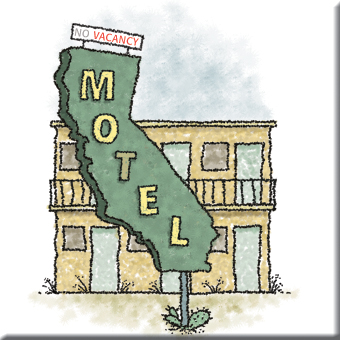What was once such a lovely place is becoming the country’s financial flophouse.
While most of us have watched, mouths agape, as the eye-rubbing economic clown parade that has been the last three years or so of American life has passed down our ply-wooded Main Streets, the collapse of California has been a true standout.
With a yawning deficit to close and a truly “end times” budget ravaging what had been one of the premier social service and educational systems in the nation, it is becoming astoundingly clear that California, always at the forefront of trends that eventually sweep the nation, could be the first of a new phenomenon: a failed state within the United States.
Just as the city of Detroit stands out as a depressing American civic innovation, the state of California, teetering on the brink between chaos and what’s left of its civil society, could be the laid-off instead of laid-back snapshot of things to come for other fiscally fragile states. Let’s hope that, unlike tofu and skateboarding, this is one California trend that doesn’t catch on.
Stumbled by its cumbersome tax structure, struggling with a still raging viral infestation of foreclosures, and suffering statewide unemployment well into the double digits, California has been printing IOUs in lieu of paychecks, shutting down schools and health programs, and furloughing state workers. For the first time in decades, the state that has drawn generations of dreamers is witnessing its hopeful dream’s decline; more than 500,000 left between 2004 and 2008.
You may already be familiar with the failed state syndrome-that is, nation-states that are no longer able to assume the basic responsibilities of government-and presumed that it’s something that happens elsewhere like the Congo or Somalia. With its abilities to provide the basics of contemporary U.S. civic life now so profoundly challenged, is California ready to join that sorry list, and more to the point, is the rest of the United States prepared to sit back and watch it happen?
In our TARPish times, when million-dollar-bonus babies at Goldman Sachs have already supped deeply at the federal trough, keeping California and its 37 million citizens from falling off the edge of the continent ought to be accepted as a legitimate federal responsibility. Remember: If California follows the model of other failed states, it is the most vulnerable who will suffer the most during the state’s downward spiral. That is already happening.
More than 60,000 state employees have been terminated, and California’s once enviable education system is unrecognizable. According to England’s Guardian, the percentage of California’s 19-year-olds in college fell from 43 percent to 30 percent between 1996 and 2004, “one of the highest falls ever recorded for any developed world economy.” California’s schools are now ranked 47th out of 50 in the nation.
The state is bartering the future to salvage its bankrupt present, a cruel and unjust template for other states who will certainly be tempted to likewise lay their fiscal burdens down across the straining backs of those citizens not protected by lobbyists or defended by special interests.
The U.S. Bishops’ pastoral letter “Economic Justice for All” states that we as American Catholics understand that “government is a means by which we can act together to protect what is important to us and to promote our common values.”
We know that in an era of fiscal scarcity and uncertainty we are particularly called to make a preferential option for the poor; we understand government’s special role in promoting the common good and protecting human dignity, a dignity that can only be assured with adequate social services and the chance for a fair-paying and life-affirming employment.
These are merely principles, not a blueprint for restructuring California’s fiscal foundation, but they are ideals that should be part of the conversation as policymakers come to terms with their own fiscal passions. Finding a way back to its golden state may be decades of work in California, but it’s work that must be distributed with an eye not just on fairness, but on mercy and compassion.
This article appeared in the January 2010 issue of U.S. Catholic (Vol. 75, No. 1, page 39).
Image: Tom Wright












Add comment